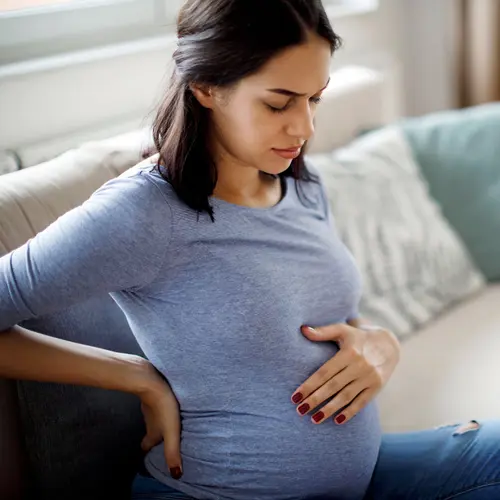Pregnancy causes many changes to your body. These physical changes may give you a higher chance of getting a postpartum hernia.
A Cesarean Section (C-section) may also be linked to a hernia after pregnancy.
What Is a Hernia?
You can get a hernia when one of your internal organs pushes through the wall of muscle or tissue. This often happens when there's a weak spot in the muscle. Most hernias appear in the area between your chest and hips, which is called the abdominal cavity.
There are several different types of hernia:
- Inguinal hernia (groin area)
- Femoral hernia (outer groin)
- Umbilical hernia (belly button)
- Hiatal (hiatus) hernia (upper stomach area)
- Incisional hernia (near an abdominal scar from an abdominal surgery)
An incisional hernia can happen months or even years after an abdominal surgery like a C-section. It happens when the cut made in your abdominal wall during surgery doesn’t close properly. This weakens your abdominal wall, and tissues or organ parts may push through.
Your risk for incisional hernias increases if you:
- Are very overweight, as there’s greater pressure on the scar tissue
- Have other illnesses and wound healing problems
- Have a larger incision
Hernias After a C-Section
When you give birth, your doctor may recommend a C-section, as it may be safer for you or your baby. A C-section is a surgery in which incisions are made in your abdomen and uterus to deliver a baby.
There are many different reasons women have a C-section. If you have increased health risks, difficulty with labor, or are carrying multiples, your doctor may recommend a C-section. Some women also opt for a C-section as they would prefer surgery over delivering a baby vaginally. C-sections are fairly common. Nearly a third of all deliveries in the U.S. are by C-section.
If you have a C-section, incisional hernias are a possible complication.
Researchers studied 57,564 women who had 68,271 C-sections. They found that an estimated 2 in 1,000 C-sections led to hernias that needed surgical repair within 10 years of the delivery. This risk was higher in the first 3 years after a C-section.
Researchers say it’s possible that more women had hernias after their C-sections, but didn't get surgery. Researchers also found that slightly more women with hernias had midline (up and down) incisions. But the transverse (side to side) incision was the more common method used in all these C-sections.
A different study of 642, 578 women found that the rate of hernia repair in women who had C-sections was 0.47%. For those who only had vaginal deliveries, this rate was 0.12%.
The risk of incisional hernia repair went up with the number of C-sections each woman had. Compared to women with no C-sections, those who had two C-sections had three times the risk. Women with five or more C-sections had six times the risk.
Symptoms of a Hernia
Not everyone with a hernia has symptoms. But some symptoms include:
- Pain. A hernia can cause discomfort and pain.
- Protrusion. You may have a bulge in your abdominal area.
- Constipation and vomiting. This means that your hernia is strangulated and cuts off your bowel.
A strangulated hernia is when the blood supply is cut off of the tissue that's trapped. This can be life-threatening.
Diagnosis of a Postpartum Hernia
Your doctor will do a physical exam and discuss your medical history. It’s usually possible to feel or see a bulge where the hernia is located. In some cases, a computed tomography (CT) scan or ultrasound may be needed.
Imaging may help your doctor find out the size of the hernia, and plan your surgery. This may be especially helpful if it’s a more complex case.
Treatment for Postpartum Hernia
If your hernia doesn’t cause problems and you have a low risk of complications, surgery isn’t always necessary. You’ll have to constantly monitor and be aware of any changes to your body. Tell your doctor if you notice any changes or symptoms.
Pregnancy can increase your risk of the hernia coming back. If you plan on having another child, talk to your doctor to see if you should consider delaying your surgery.
If your hernia is large and you have symptoms, you’ll need surgery. This will help to avoid further complications and to relieve your symptoms.
If your incisional hernia happens a few weeks after your C-section, it likely won’t be repaired immediately. Your doctor will want to give your abdominal wall time to recover.
Surgery. Hernia surgery can be done as:
- Open surgery. Your abdomen will be cut open, and the opening of the hernia closed.
- Laparoscopic (keyhole) surgery. Your doctor will make several small cuts through which surgical instruments are inserted.
Your surgeon may also place a mesh in your abdomen during surgery. This can help strengthen your abdominal wall and help your tissue heal.
Using a surgical mesh can reduce your likelihood of having an incisional hernia again. With a mesh, there’s a 5% to 10% likelihood of it coming back, but with just stitches, this likelihood is 30% to 40%.
Abdominal binder. After your surgery, your doctor may recommend that you wear an abdominal binder as much as possible. An abdominal binder is a wide belt that goes around your abdomen. It will help relieve pressure on your back and help support your abdomen.
Studies have shown that using an abdominal binder after an incisional hernia repair surgery may help decrease pain.

